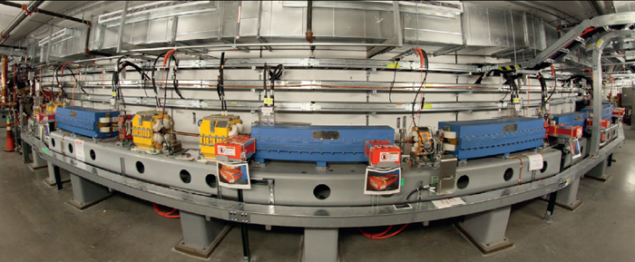
Image credit: Pavel Cheblakov.
The National Synchrotron Light Source II (NSLS-II) is currently being commissioned at Brookhaven National Laboratory. When completed, it will be a state-of-the-art, medium-energy electron storage ring producing X-rays up to 10,000 times brighter than the original NSLS, which started operating at BNL in 1982 and will be shut down at the end of September.
The injector system includes a 200 MeV linac and booster with energy up to 3 GeV. The booster is a joint venture between the NSLS-II injector group and the Budker Institute of Nuclear Physics (BINP) in Novosibirsk, one of the NSLS-II partners. BINP has a solid relationship with the Brookhaven lab and has played a significant role in NSLS-II development, coming up with the final design of the booster. The institute has its own well-developed workshops and a variety of specialists, who are not only involved in many major international projects but also operate the VEPP-2000 and VEPP-4M colliders.
In May 2010, according to tender results, a contract was signed between Brookhaven and BINP on the manufacturing, installation and commissioning of the turnkey booster (except an RF system). One year later, Brookhaven staff visited BINP and accepted all first articles. Most of the components – including the magnets, power supplies, diagnostic systems, injection-extraction system – were made at BINP. However, BINP also engaged subcontractors, including European firms. For example, power supplies for the booster dipole magnets were produced by Danfysik A/S.
An 11-hour time difference between Novosibirsk and New York did not prevent good interaction between the laboratories. In the morning and evening, Brookhaven and BINP experts usually made contact to discuss the latest achievements and pose new questions. So the Sun never set over the booster project.
Booster parts arrived at Brookhaven from January through to August 2012. Most of the components came as girder assemblies with magnets aligned to tens of microns, and vacuum chambers installed. The journey of more than 10,000 km was made first by road from Novosibirsk to St Petersburg and then to New York by ship. Upon arrival at Brookhaven, all assemblies were thoroughly tested, but the long journey did not affect the alignment of magnets on the girders.
The testing and installation activities have spanned both organizations. The booster commissioning also involved staff from both NSLS-II and BINP. Following authorization, the commissioning of the booster started in December 2013 and was successfully completed in February 2014, ahead of schedule. The beam passing through booster was up to 95%, with all systems working according to design.
The commissioning of the main storage ring started in March and on 11 July, NSLS-II reached a current of 50 mA at 3 GeV, using a new superconducting radio-frequency cavity. The second cavity and other hardware are still to be installed before the accelerator reaches the full design current of 500 mA. The next step is commissioning insertion devices and front-ends.





